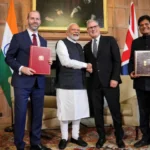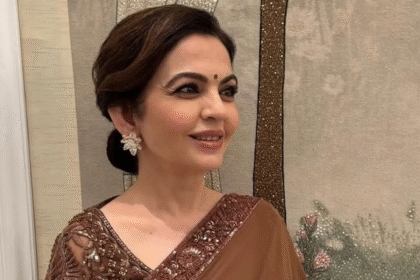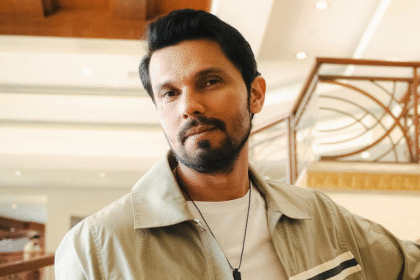PM Modi Arrives in Maldives, Welcomed by President Mohamed Muizzu | Watch Highlights
PM Modi arrives in Maldives and is warmly received by President Mohamed Muizzu. Watch the highlights of PM Modi’s visit and the ceremonial welcome in Male.
The Arrival Ceremony and Symbolism
On a bright morning that carried the distinct salty breeze of the Indian Ocean, Indian Prime Minister Narendra Modi touched down at Velana International Airport in Male, Maldives. The visit marked his first trip to the island nation during the presidency of Mohamed Muizzu — a leader whose early months in office had been characterized by shifting diplomatic winds and cautious rhetoric vis-à-vis New Delhi.
As the aircraft stairs descended and Prime Minister Modi stepped onto Maldivian soil, he was warmly received by President Mohamed Muizzu himself, accompanied by a full ceremonial guard of honor. The moment was more than just a formal protocol — it was an opportunity for both nations to recalibrate their strategic alignment in the region.
The optics were striking: flags of both nations fluttering in tandem, traditional Maldivian dancers performing in graceful harmony, and both leaders exchanging cordial greetings with visible intent. Indian and Maldivian media outlets streamed the visuals live, interpreting the choreography of the reception as a symbolic gesture aimed at regional reconciliation.
For Prime Minister Modi, this visit served multiple purposes. Domestically, it bolstered his image as a leader strengthening India’s neighborhood-first policy. Internationally, it was a signal that India remains committed to deepening ties with its Indian Ocean neighbors despite recent diplomatic strains.
President Muizzu’s decision to personally receive Modi at the airport was not just a display of courtesy but also a calculated diplomatic maneuver. Observers noted that Muizzu — who had previously called for the withdrawal of Indian military personnel stationed in the Maldives — seemed eager to strike a tone of moderation and mutual respect.
Inside the airport’s reception hall, both leaders shared a brief but meaningful conversation before proceeding to their respective convoys. Security was tight, but the atmosphere was celebratory. Schoolchildren lined the roads waving Indian and Maldivian flags, while local residents looked on with cautious optimism.
As the convoys made their way through Male’s narrow but well-decorated streets, the symbolism of Modi’s visit began to take root. India has long been one of the Maldives’ largest development partners — from providing critical infrastructure support to timely humanitarian assistance during crises. Yet, the recent political shift in Malé had created some turbulence in bilateral relations.
Back in New Delhi, officials had worked behind the scenes to ensure that Modi’s visit would not merely be a photo-op but a substantive engagement. The Indian delegation included senior diplomats, strategic advisors, and key representatives from commerce and defense sectors — underlining the comprehensive nature of the discussions that were to follow.
Strategic Background
India and Maldives share more than just geography. The two countries have historically enjoyed a close relationship shaped by cultural ties, trade routes, and shared security concerns. India’s swift response to the 1988 coup attempt in the Maldives under Operation Cactus is often cited as a defining moment in their strategic partnership. However, the emergence of new political players in Malé in recent years had brought challenges to that status quo.
President Muizzu’s rise to power was accompanied by strong nationalist rhetoric and a pro-sovereignty stance that resonated with sections of the Maldivian electorate wary of foreign influence — including that of India. During his campaign, he pledged to review and reconsider agreements signed with India, especially concerning Indian defense personnel and equipment deployed in Maldivian territory.
That context made Modi’s visit even more important. It was a diplomatic bridge-building mission in every sense. And by choosing to land in Maldives before heading to other Indian Ocean partners, Modi underscored New Delhi’s commitment to dialogue, mutual respect, and regional cooperation.
The Ceremonial Grand Welcome
Upon arrival at the Presidential Jetty in Male, a ceremonial welcome was held in full view of the public and media. Traditional Maldivian drums — “Boduberu” — resounded across the premises as Prime Minister Modi walked alongside President Muizzu. The Indian Tricolour and the Maldivian Crescent waved side by side atop the ceremonial arches. It was both a nod to friendship and an attempt to reframe the narrative that had recently veered toward skepticism.
A special highlight of the welcome event was a multi-faith prayer conducted by local religious leaders, symbolizing both countries’ respect for religious diversity and shared heritage. This moment, too, was keenly observed by commentators who noted that such symbolism was aimed at softening ideological divides and projecting inclusiveness.
The Indian Embassy in Malé issued a brief statement shortly after the event, saying:
“Prime Minister Narendra Modi’s visit to the Maldives reflects the deep-rooted friendship and long-standing partnership between our two nations. The ceremonial welcome was a testament to the strong cultural and diplomatic bonds that unite us.”
People-to-People Ties and Cultural Diplomacy
Parallel to the diplomatic engagements, cultural exchanges formed an essential part of Modi’s visit. The Indian Cultural Center in Male organized a traditional Indian dance performance in the evening, featuring classical Kathak, Bharatanatyam, and fusion acts combining Indian and Maldivian musical styles.
This soft diplomacy wasn’t an afterthought — it was central to New Delhi’s outreach strategy. India has increasingly relied on people-to-people diplomacy to win hearts in its neighboring countries, especially where geopolitical narratives are prone to be influenced by external powers, including China.
Maldivian students, artists, business leaders, and civil society representatives were also invited to interact with the Indian delegation, including officials from India’s Ministry of External Affairs. A joint art exhibition showcasing historical connections between the two nations, including shared maritime trade history, was inaugurated at the National Museum of Maldives.
Such efforts are more than aesthetic. They provide platforms to reinforce positive narratives and neutralize misinformation — particularly at a time when regional powers are competing for influence in the Indian Ocean Region.
Strategic Talks, Bilateral Commitments, and Regional Chessboard
As the warm reception ceremonies concluded and the symbolic gestures made their mark, the visit transitioned into its more substantive phase: high-level bilateral talks between Prime Minister Narendra Modi and Maldivian President Mohamed Muizzu.
Behind the scenes at the Presidential Palace in Malé, a more pragmatic tone emerged. Both leaders were aware that beyond handshakes and ceremonies, the future of India–Maldives relations would be defined by the agreements and understandings forged in these private discussions.
The closed-door bilateral meeting began with introductory statements by both leaders, with a firm emphasis on regional cooperation, maritime security, economic development, and mutual respect for sovereignty. Observers noted that both sides arrived at the table with caution, but also with purpose.
Resetting the Dialogue
PM Modi began by reiterating India’s continued commitment to its “Neighbourhood First” policy, noting that the Maldives holds a “central place in India’s maritime vision.” He stressed that bilateral cooperation should not be hostage to internal political shifts, and that India’s intent was to work with the democratically elected leadership of the Maldives — irrespective of ideological alignment.
President Muizzu, in turn, acknowledged India’s long-standing contributions to Maldives’ infrastructure, healthcare, and emergency response efforts. However, he also raised “public sentiment” concerns regarding the presence of Indian military personnel stationed at key installations in the Maldives — a sticking point since Muizzu’s campaign days.
Sources within both governments later confirmed that while the issue of troop presence was not resolved in absolute terms, a framework was being developed for phased withdrawal of Indian military staff from non-strategic civilian support roles, without compromising the Indian-assisted hydrographic and aviation systems that support the Maldivian coast guard.
This balancing act was described by a senior Indian diplomat as “realpolitik at its best — mutual recalibration without dramatic retreat.”
Key Agreements Signed
The bilateral dialogue was followed by the signing of several MoUs (Memoranda of Understanding) that signaled a reaffirmation of practical cooperation, even amid ideological divergence. The key agreements included:
- Maritime Surveillance Support Agreement:
India will continue to assist Maldives in surveillance and patrol missions in its Exclusive Economic Zone (EEZ), but operational control will increasingly be handed over to Maldivian personnel over a two-year horizon. - Infrastructure and Connectivity Grant:
India committed ₹800 crore (approx. $95 million) towards the Male–Thilafushi sea bridge project, which will dramatically improve urban connectivity and decongest the capital. - Water Sanitation and Disaster Resilience Program:
A new climate-resilient infrastructure initiative, under India’s grant assistance framework, will be launched to support the outer islands of the Maldives facing climate-induced erosion and freshwater scarcity. - Education & Cultural Exchange Framework (2025–2030):
India pledged scholarships for 400 Maldivian students annually and cultural exchange programs targeting art, science, and sports. - Health Corridor Initiative:
India’s Apollo Hospitals Group and Maldives’ Ministry of Health signed an MoU to develop two specialty hospitals on Laamu and Addu atolls. India also committed to supplying 30 advanced dialysis units.
Each agreement reflected a conscious shift toward civilian capacity-building over military dependency. The focus was on health, climate, trade, and education — domains where Indian assistance remains politically palatable and developmentally impactful.
The India–China Shadow
Though not officially mentioned in public statements, the China factor loomed large over the visit. China’s increasing footprint in the Maldives — through infrastructure loans, port development, and technology agreements — has triggered both interest and anxiety in the region.
PM Modi’s visit, therefore, was also a subtle signal to Beijing: India is not retreating from its sphere of influence. It is adapting.
In fact, during a media interaction, an Indian foreign ministry spokesperson hinted that India is willing to coexist with other partners in the Maldives as long as transparency, sovereignty, and debt sustainability are respected.
For its part, the Maldivian leadership appears keen on pursuing a “India Plus” foreign policy, seeking to balance China’s economic appeal with India’s developmental commitment and people-to-people trust.
A Maldivian official close to the President’s office reportedly said:
“China brings finance. India brings friendship. The Maldives cannot afford to lose either.”
This delicate diplomatic triangulation is not unique to the Maldives — Sri Lanka, Bangladesh, and Nepal have all faced similar foreign policy puzzles in recent years.
Mutual Perception Management
One of the unspoken aims of Modi’s visit was to reset public perception — especially among Maldivians who had, over time, become suspicious of India’s strategic role. To address this, both sides agreed to:
- Launch a joint public information campaign showcasing India-supported civil projects.
- Create a Joint Oversight Mechanism with both Indian and Maldivian officials to ensure transparency in the deployment of Indian assets and personnel.
- Involve local Maldivian contractors and workforce in Indian-funded projects to mitigate the perception of external domination.
This focus on local ownership and visible benefits is crucial to restoring grassroots support for the India-Maldives relationship — especially as Muizzu’s government remains sensitive to public opinion and electoral messaging.
Regional and Global Reactions
The United States, Australia, and Japan — all of whom are stakeholders in the Indo-Pacific strategic architecture — quietly welcomed Modi’s outreach. A statement from the U.S. Department of State described the engagement as “a welcome example of democratic neighbors resolving differences through dialogue and development.”
China, while not issuing any formal statement, ran several state-media stories emphasizing its ongoing partnership with the Maldives, highlighting their own bilateral projects as evidence of “trusted cooperation.”
Within India, political observers from both sides of the spectrum appreciated Modi’s tone — firm yet non-confrontational, strategic yet respectful. The opposition parties in India, often critical of the government’s aggressive diplomacy, praised the balanced messaging and the focus on development assistance.
Domestic Optics, Political Undertones, and Internal Calculations in Malé
Even as the ceremonial grandeur and bilateral agreements from Prime Minister Narendra Modi’s visit to the Maldives drew headlines internationally, the undercurrents within Maldivian domestic politics were equally significant. Inside Malé’s political circles, the visit was seen not only through the lens of diplomacy but also as a subtle realignment of power equations, public sentiment, and electoral calculations.
Mohamed Muizzu: Between Mandate and Maneuver
When President Mohamed Muizzu took office in late 2023, he did so riding a wave of populist sentiment laced with strong rhetoric about Maldivian sovereignty, often framed in opposition to foreign military presence — particularly that of India. His campaign’s “India Out” slogan gained traction among nationalist groups, fishermen’s unions, and parts of the conservative religious bloc that viewed India’s presence as overbearing and opaque.
However, governance — especially in a small island nation that is highly dependent on international aid and external cooperation — demands a more nuanced approach than campaigning. And Muizzu, a civil engineer by training and technocrat by background, has increasingly shown signs of political realism.
Modi’s visit provided Muizzu with a rare opportunity to recalibrate his position. By welcoming the Indian leader personally and engaging in high-level talks, he projected maturity on the international stage. At the same time, his emphasis on troop withdrawal during bilateral discussions allowed him to retain credibility among his core voter base.
This dual-track diplomacy — reconciling nationalist campaign promises with geopolitical necessities — reflects Muizzu’s attempt to consolidate power while not isolating Maldives from crucial regional partnerships.
A member of the ruling Progressive Party of Maldives (PPM) commented anonymously:
“Muizzu cannot afford to appear anti-India at the cost of development. The visit helped him reset the narrative — from confrontation to cooperation, on his terms.”
The Opposition’s Calculated Silence
Interestingly, Maldives’ main opposition party, the Maldivian Democratic Party (MDP), which traditionally maintained closer ties with India, adopted a measured silence during Modi’s visit. Some former MDP leaders quietly welcomed the outreach, but there were no aggressive public statements, either in favor or against the visit.
Political analysts believe the opposition recognized that the visit’s optics were too strong to oppose — a warm welcome by the President, public approval of Indian-led development projects, and visible respect between the two governments. Any criticism would risk alienating voters who value economic growth and international legitimacy.
Moreover, the Maldivian business community — particularly stakeholders in tourism, construction, and education — had already begun lobbying quietly in favor of repairing ties with India, given the volume of Indian outbound tourists and the scale of Indian investment in infrastructure.
Media Landscape: Navigating Narratives
The Maldivian press displayed a notable shift in tone. Several outlets that had earlier echoed skepticism toward India began highlighting the economic and humanitarian benefits of Indian assistance. Editorials praised India’s climate-friendly projects, scholarships for Maldivian students, and its steady supply of medicines and essentials during past crises — particularly during the COVID-19 pandemic and tsunami aftermath.
In particular, state media ran a documentary-styled segment titled “Friends Across the Ocean: Maldives and India”, featuring interviews with Maldivian nurses, engineers, and students who had benefitted from Indian initiatives.
However, not all media voices were aligned. Some hardline nationalist platforms and social media influencers continued to raise concerns about “foreign dependency,” warning that economic aid should not be allowed to mask strategic encroachments.
This tug-of-war in public discourse reveals the sensitive balance Maldivian society faces — proud of its sovereignty, but aware of its vulnerability as a small nation amidst great-power rivalries.
Public Sentiment: Skepticism Softened by Pragmatism
On the streets of Malé, the mood was more measured than ideological. Local taxi drivers, hotel staff, and café owners expressed appreciation for improved infrastructure and health access, even as some retained discomfort about foreign troop presence.
Rashid, a 31-year-old shopkeeper near the Fish Market, said:
“We don’t want armies here, but we do want roads, hospitals, and schools. If India helps with that, why not?”
This blend of skepticism and pragmatism is typical of smaller nations navigating regional giants. While the public may be wary of strategic overreach, tangible development is rarely rejected — especially when it improves daily life.
The key for India moving forward, therefore, lies in ensuring visibility, transparency, and community involvement in every project — a lesson New Delhi has learned the hard way in other South Asian nations like Nepal and Sri Lanka.
Civil Society and Religious Institutions
Civil society groups in the Maldives played an understated but important role during the visit. Environmental organizations welcomed India’s emphasis on climate-resilient development, especially for atolls at risk from rising sea levels. Education NGOs praised the scholarship and exchange program expansion.
However, religious institutions remained cautious. While there were no direct protests, some imams and religious scholars subtly reminded followers of the need to “protect Maldivian Islamic values” amid growing foreign partnerships. It’s worth noting that India has handled this space tactfully by avoiding cultural impositions and respecting Maldivian religious autonomy.
One notable gesture was PM Modi’s visit to the Islamic Centre of Malé, where he made a donation to the library and praised Maldives’ historic preservation of Islamic scholarship. The move earned him cautious approval from moderate clerics and was widely covered in both Indian and Maldivian media.
The Symbolism of Youth Engagement
Perhaps one of the smartest elements of Modi’s itinerary was his interaction with Maldivian youth — a demographic that makes up over 60% of the country’s population. He visited the Maldives National University, where he inaugurated a new India-funded digital research lab and engaged in a Q&A session with students.
In a speech delivered without a teleprompter, Modi spoke about the “Ocean of Opportunities” and urged Maldivian youth to see India not as a competitor or colonizer, but as a “partner in growth and guardianship of the shared Indian Ocean.”
Student reactions were overwhelmingly positive. Social media posts from attendees went viral with hashtags like #ModiInMaldives and #IndiaMaldivesFuture, signaling a generational shift in perception. When asked by a student whether India was trying to “control” the Maldives, Modi smiled and replied:
“Friends don’t need to control. They need to care.”
The moment was replayed across news channels in both countries and is now being touted as a PR masterstroke that directly addressed the trust deficit among the younger, more digitally connected audience.
Also Read : India-UK FTA Signed: Imported British Cars Set to Get Cheaper in India








